Anion currents in yeast K+ transporters (TRK) characterize a structural homologue of ligand-gated ion channels
- PMID: 21556692
- PMCID: PMC3151154
- DOI: 10.1007/s00424-011-0959-9
Anion currents in yeast K+ transporters (TRK) characterize a structural homologue of ligand-gated ion channels
Abstract
Patch clamp studies of the potassium-transport proteins TRK1,2 in Saccharomyces cerevisiae have revealed large chloride efflux currents: at clamp voltages negative to -100 mV, and intracellular chloride concentrations >10 mM (J. Membr. Biol. 198:177, 2004). Stationary-state current-voltage analysis led to an in-series two-barrier model for chloride activation: the lower barrier (α) being 10-13 kcal/mol located ~30% into the membrane from the cytoplasmic surface; and the higher one (β) being 12-16 kcal/mol located at the outer surface. Measurements carried out with lyotrophic anions and osmoprotective solutes have now demonstrated the following new properties: (1) selectivity for highly permeant anions changes with extracellular pH; at pH(o)= 5.5: I(-)≈ Br(-) >Cl(-) >SCN(-) >NO (3)(-) , and at pH(o) 7.5: I(-)≈ Br(-) > SCN(-) > NO(3)(-) >Cl(-). (2) NO(2)(-) acts like "superchoride", possibly enhancing the channel's intrinsic permeability to Cl(-). (3) SCN(-) and NO(3)(-) block chloride permeability. (4) The order of selectivity for several slightly permeant anions (at pH(o)= 5.5 only) is formate>gluconate>acetate>>phosphate(-1). (5) All anion conductances are modulated (choked) by osmoprotective solutes. (6) The data and descriptive two-barrier model evoke a hypothetical structure (Biophys. J. 77:789, 1999) consisting of an intramembrane homotetramer of fungal TRK molecules, arrayed radially around a central cluster of four single helices (TM7) from each monomer. (7) That tetrameric cluster would resemble the hydrophobic core of (pentameric) ligand-gated ion channels, and would suggest voltage-modulated hydrophobic gating to underlie anion permeation.
Figures
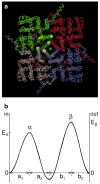

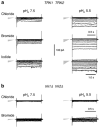
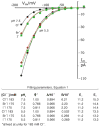
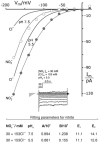
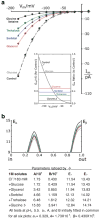

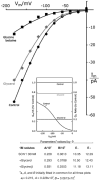
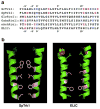
Similar articles
-
A structural model for facultative anion channels in an oligomeric membrane protein: the yeast TRK (K(+)) system.Pflugers Arch. 2015 Dec;467(12):2447-60. doi: 10.1007/s00424-015-1712-6. Epub 2015 Jun 24. Pflugers Arch. 2015. PMID: 26100673
-
Mechanism of anion permeation through channels gated by glycine and gamma-aminobutyric acid in mouse cultured spinal neurones.J Physiol. 1987 Apr;385:243-86. doi: 10.1113/jphysiol.1987.sp016493. J Physiol. 1987. PMID: 2443667 Free PMC article. Review.
-
Quantitative modeling of chloride conductance in yeast TRK potassium transporters.Biophys J. 2005 Oct;89(4):2412-26. doi: 10.1529/biophysj.105.066712. Epub 2005 Jul 22. Biophys J. 2005. PMID: 16040756 Free PMC article.
-
Anion permeation in Ca(2+)-activated Cl(-) channels.J Gen Physiol. 2000 Dec;116(6):825-44. doi: 10.1085/jgp.116.6.825. J Gen Physiol. 2000. PMID: 11099350 Free PMC article.
-
Emerging issues of connexin channels: biophysics fills the gap.Q Rev Biophys. 2001 Aug;34(3):325-472. doi: 10.1017/s0033583501003705. Q Rev Biophys. 2001. PMID: 11838236 Review.
Cited by
-
Potassium supply and homeostasis in the osmotolerant non-conventional yeasts Zygosaccharomyces rouxii differ from Saccharomyces cerevisiae.Curr Genet. 2012 Dec;58(5-6):255-64. doi: 10.1007/s00294-012-0381-7. Epub 2012 Sep 5. Curr Genet. 2012. PMID: 22948499
-
Genome-wide search for candidate genes for yeast robustness improvement against formic acid reveals novel susceptibility (Trk1 and positive regulators) and resistance (Haa1-regulon) determinants.Biotechnol Biofuels. 2017 Apr 19;10:96. doi: 10.1186/s13068-017-0781-5. eCollection 2017. Biotechnol Biofuels. 2017. PMID: 28428821 Free PMC article.
-
Quantitative description of ion transport via plasma membrane of yeast and small cells.Front Plant Sci. 2015 Jun 11;6:425. doi: 10.3389/fpls.2015.00425. eCollection 2015. Front Plant Sci. 2015. PMID: 26113853 Free PMC article. Review.
-
Evolutionary engineering in Saccharomyces cerevisiae reveals a TRK1-dependent potassium influx mechanism for propionic acid tolerance.Biotechnol Biofuels. 2019 Apr 23;12:97. doi: 10.1186/s13068-019-1427-6. eCollection 2019. Biotechnol Biofuels. 2019. PMID: 31044010 Free PMC article.
-
Organic Acid Excretion in Penicillium ochrochloron Increases with Ambient pH.Front Microbiol. 2012 Apr 4;3:121. doi: 10.3389/fmicb.2012.00121. eCollection 2012. Front Microbiol. 2012. PMID: 22493592 Free PMC article.
References
-
- Back JF, Oakenfull D, Smith MB. Increased thermal stability of proteins in the presence of sugars and polyols. Biochem. 1979;18:5191–5196. - PubMed
-
- Beckstein O, Biggin PC, Sansom MSP. A hydrophobic gating mechanism for nanopores. J Phys Chem B. 2001;105:12902–12905.
-
- Beckstein O, Sansom MSP. A hydrophobic gate in an ion channel: the closed state of nicotinic acetylcholine receptor. Phys Biol. 2006;3:147–159. - PubMed
Publication types
MeSH terms
Substances
Grants and funding
LinkOut - more resources
Full Text Sources
Other Literature Sources
Medical
Molecular Biology Databases

